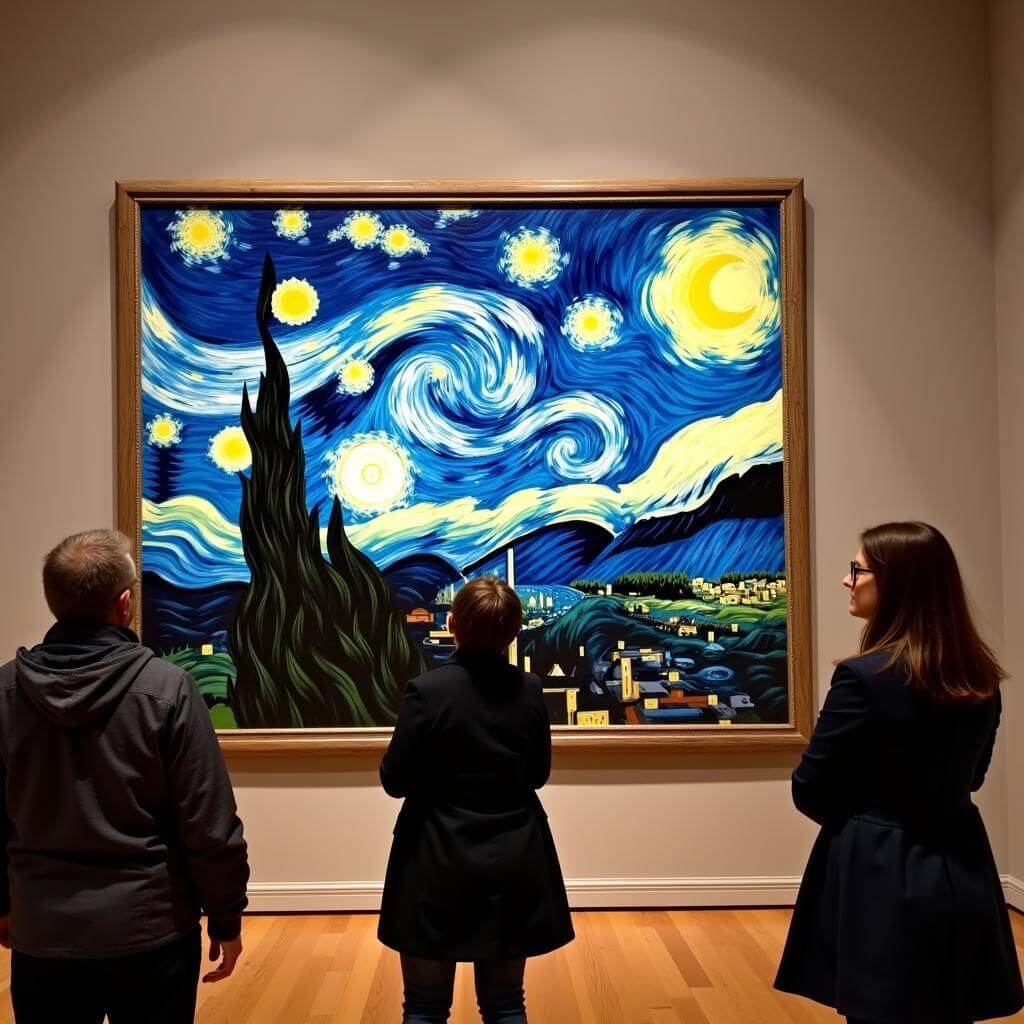The IELTS Speaking test often includes questions about art and culture, making “describe a famous painter or artist from your country” a common topic. This article will guide you through answering such questions effectively, providing sample responses for different band scores and valuable tips to excel in your IELTS Speaking exam.
Table Of Contents
Part 1: Introduction and Interview
In this section, the examiner may ask general questions about art and artists. Here are some potential questions with sample answers:
- Do you enjoy art?
Band 6-7 answer:
“Yes, I do enjoy art. I find it interesting to look at paintings and sculptures in museums. It’s a nice way to spend free time.”
Band 8-9 answer:
“Absolutely! I’m quite passionate about art. I find it captivating how artists can express complex emotions and ideas through visual media. Visiting art galleries and exhibitions is one of my favorite pastimes.”
- Have you ever tried painting or drawing?
Band 6-7 answer:
“Yes, I’ve tried painting a bit. I’m not very good at it, but I find it relaxing. I mostly do simple landscapes or still life drawings.”
Band 8-9 answer:
“Indeed, I’ve dabbled in both painting and drawing. While I wouldn’t consider myself particularly talented, I find the process incredibly therapeutic. I especially enjoy experimenting with watercolors to capture the essence of nature scenes.”
 Famous artist painting in studio with easel and canvas
Famous artist painting in studio with easel and canvas
Part 2: Long Turn
Cue Card
Describe a famous painter or artist from your country
You should say:
- Who this person is
- What kind of art they create
- How you learned about this artist
- And explain why you think they are famous
Band 6-7 Sample Answer:
“I’d like to talk about a famous painter from my country named Van Gogh. He’s known for his colorful paintings of landscapes and flowers. I first learned about him in school during art class. We studied some of his famous works like ‘Starry Night’ and ‘Sunflowers’.
Van Gogh is famous because his paintings are very unique and emotional. He used bright colors and thick brush strokes that make his art stand out. Many people around the world recognize his style.
Even though he wasn’t very successful during his lifetime, his paintings are now worth millions of dollars. I think he’s famous because his art touches people’s hearts and shows beauty in everyday scenes.”
Band 8-9 Sample Answer:
“I’d like to delve into the life and work of Vincent van Gogh, an iconic Dutch post-impressionist painter who has left an indelible mark on the art world. Van Gogh is renowned for his vibrant, emotive paintings that capture landscapes, still lifes, and portraits with extraordinary intensity.
I first encountered Van Gogh’s work during a school trip to the Van Gogh Museum in Amsterdam. The experience was truly eye-opening, as I was immediately captivated by the raw emotion and dynamic energy emanating from his canvases.
Van Gogh’s artistic style is characterized by bold colors, expressive brushstrokes, and a unique perspective on everyday subjects. His most famous works, such as ‘The Starry Night’ and ‘Sunflowers’, exemplify his ability to infuse ordinary scenes with a sense of wonder and vitality.
The reasons behind Van Gogh’s enduring fame are multifaceted. Firstly, his distinctive style revolutionized the art world and paved the way for modern art movements. Secondly, the poignant story of his life – marked by struggles with mental health and lack of recognition during his lifetime – adds a layer of intrigue and empathy to his work. Lastly, the sheer emotional power of his paintings continues to resonate with people across generations and cultures, cementing his status as one of the most influential artists in history.”
Follow-up Questions
- How has this artist influenced modern art in your country?
Band 6-7 answer:
“Van Gogh has influenced modern art in the Netherlands by inspiring many artists to use bold colors and express emotions in their paintings. His style can be seen in some contemporary Dutch artists’ work.”
Band 8-9 answer:
“Van Gogh’s influence on modern Dutch art is profound and far-reaching. His innovative use of color and expressive brushwork have inspired generations of artists to push the boundaries of traditional artistic conventions. Many contemporary Dutch artists draw inspiration from Van Gogh’s fearless approach to capturing emotion on canvas, resulting in a vibrant and diverse art scene that continues to evolve and flourish.”
- Do you think it’s important for a country to have famous artists?
Band 6-7 answer:
“Yes, I think it’s important. Famous artists can help promote a country’s culture and attract tourists. They also inspire young people to be creative.”
Band 8-9 answer:
“Absolutely. Famous artists play a crucial role in shaping a nation’s cultural identity and fostering artistic innovation. They serve as cultural ambassadors, elevating their country’s profile on the global stage and attracting international interest. Moreover, renowned artists often inspire future generations, nurturing creativity and encouraging artistic pursuits within society. This ripple effect can lead to a thriving arts scene, which in turn contributes significantly to a country’s cultural and economic development.”
 Van Gogh's Starry Night painting in museum
Van Gogh's Starry Night painting in museum
Part 3: Two-way Discussion
Examiner: “Let’s talk about the role of art in society.”
- How do you think art influences people’s daily lives?
Band 6-7 answer:
“Art influences people’s daily lives in many ways. It can make public spaces more beautiful with sculptures and murals. People also use art to decorate their homes and express themselves through fashion. Art in movies and advertising also affects our choices and opinions.”
Band 8-9 answer:
“Art permeates virtually every aspect of our daily lives, often in ways we might not immediately recognize. On a macro level, public art installations and architecture shape our urban landscapes, influencing our mood and perception of spaces. In our personal spheres, art manifests in the design of everyday objects, from the clothes we wear to the furniture we use, reflecting and informing our individual tastes and identities.
Moreover, art in media – be it in film, advertising, or social platforms – plays a significant role in shaping cultural narratives and societal values. It can challenge our perspectives, evoke emotions, and spark conversations on important issues. In essence, art serves as a powerful lens through which we interpret and interact with the world around us, subtly guiding our choices, opinions, and even our understanding of ourselves and others.”
- Do you believe that government funding for the arts is important? Why or why not?
Band 6-7 answer:
“Yes, I think government funding for arts is important. It helps support museums and galleries, which are good for education and tourism. It also helps artists create new work that might not be possible without financial support.”
Band 8-9 answer:
“Government funding for the arts is absolutely crucial for several compelling reasons. Firstly, it ensures the preservation and development of a nation’s cultural heritage, which is integral to maintaining national identity and fostering social cohesion. Public funding allows for the maintenance of museums, galleries, and historical sites that serve as repositories of our collective history and culture.
Secondly, government support cultivates artistic innovation by providing artists with the resources to push creative boundaries without being solely constrained by commercial viability. This nurtures a diverse and vibrant arts scene that can address complex societal issues and contribute to public discourse.
Furthermore, arts funding plays a vital role in education, supporting programs that develop critical thinking, creativity, and empathy in young people. It also contributes significantly to the economy through cultural tourism and creative industries.
Lastly, public funding ensures accessibility to the arts for all members of society, regardless of socioeconomic status. This democratization of art is essential for fostering a well-rounded, culturally literate population. In essence, government funding for the arts is an investment in the social, educational, and economic well-being of a nation.”
 Government funding for the arts infographic chart
Government funding for the arts infographic chart
Key Vocabulary and Phrases for High Scores
-
Iconic (adjective) /aɪˈkɒnɪk/ – Very famous or popular, especially being considered to represent particular opinions or a particular time
Example: “The Mona Lisa is an iconic painting known worldwide.” -
Indelible mark (phrase) /ɪnˈdelɪbl mɑːk/ – A lasting impression or effect
Example: “Picasso’s work left an indelible mark on 20th-century art.” -
Captivate (verb) /ˈkæptɪveɪt/ – To attract and hold the interest and attention of; charm
Example: “Van Gogh’s use of color captivates viewers even today.” -
Exemplify (verb) /ɪɡˈzemplɪfaɪ/ – To be a typical example of
Example: “Monet’s ‘Water Lilies’ series exemplifies the Impressionist style.” -
Pave the way (idiom) /peɪv ðə weɪ/ – To make subsequent development or progress easier
Example: “Cubism paved the way for abstract art movements.”
Examiner’s Advice
To achieve a high score in the IELTS Speaking test when discussing famous artists or painters:
-
Expand your art vocabulary: Learn and use specific terms related to art styles, techniques, and movements.
-
Practice describing artworks: Regularly describe paintings or sculptures to improve your descriptive language.
-
Stay informed: Read about current art trends and exhibitions to provide relevant examples.
-
Develop personal opinions: Be prepared to explain why you like or dislike certain artists or artworks.
-
Use complex sentence structures: Incorporate a mix of simple and complex sentences to demonstrate linguistic flexibility.
-
Connect ideas: Use linking words and phrases to create cohesive responses.
-
Speak confidently: Even if you’re unsure about some details, maintain a confident tone and focus on what you do know.
Remember, the key to success in the IELTS Speaking test is not just about art knowledge, but about communicating your ideas clearly and effectively. Practice regularly and seek feedback to continually improve your speaking skills.


